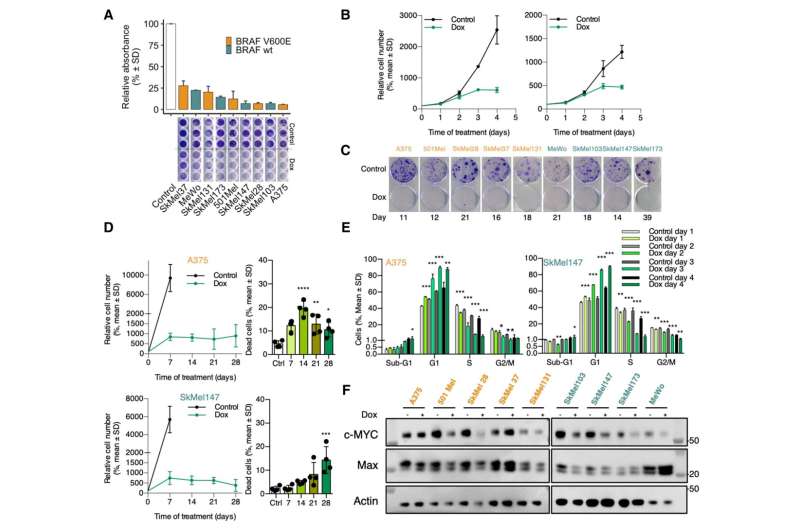This article has been reviewed according to Science X's editorial process and policies. Editors have highlighted the following attributes while ensuring the content's credibility:
fact-checked
peer-reviewed publication
proofread
MYC inhibition in melanoma: Preclinical promise and the unveiling of a prognostic gene signature

Cutaneous melanoma, the most aggressive form of skin cancer, is the fifth most diagnosed cancer in Europe and one of the most frequent causes of cancer death, with incidence and mortality trends on the rise. While the development of more effective treatments including immune-based approaches have improved survival in some patients, many do not benefit from these anti-cancer therapies due to intrinsic or acquired drug resistance.
"In 2020, over 105,000 people were diagnosed with cutaneous melanoma and 16,000 died of this disease in the EU. Rising incidence and mortality rates also illuminate the urgent need to develop new, more effective therapies against this tumor type," says Laura Soucek, co-Director of the Vall d'Hebron Institute of Oncology's (VHIO) Preclinical and Translational Research Program, and Principal Investigator of our Models of Cancer Therapies Group.
Built on over 20 years of research led by Laura Soucek, the Omomyc (OMO-103) therapeutic mini-protein was developed in-house by the VHIO and Catalan Institute of Research and Advanced Studies' (ICREA) spin-off company Peptomyc S.L., which she co-founded in 2014. Having previously shown the preclinical efficacy and safety of this novel cell-penetrating mini-protein in mouse models, her team successfully developed anti-MYC peptides for the treatment of several tumor types.
Omomyc is showing increasing promise in becoming the first ever clinically viable and direct inhibitor of the MYC oncogene—a transcription factor and major driver of multiple tumor types. This novel MYC inhibitor has now successfully completed a phase I clinical trial.
Published in the journal Genes & Development, results of a study directed by Soucek now demonstrate the preclinical promise of Omomyc in opening up a new treatment avenue for patients with melanoma.
"The deregulation of MYC, occurring in up to 70% of human cancers, induces the transcription of genes implicated in myriad processes including the development of metastases and disease recurrence. The overexpression of this protein is found in 34% of melanomas and associates with increased aggressiveness of disease and several pathways of treatment resistance. MYC inhibition could therefore promise an important therapeutic impact against this disease," observes Soucek, CEO of Peptomyc, an ICREA Research Professor and co-corresponding author of this study.
"Preclinical data from this present study show that reducing MYC's transcriptional footprint by the transgenic expression of Omomyc, achieves a significant reduction in tumor growth and metastatic capacity, independently of the driver mutation," adds Mariano F. Zacarías-Fluck, Research Associate of VHIO's Models of Cancer Therapies Group and co-corresponding author of this study.
The investigators report that MYC inhibitions halts the transcription of genes implicated in cell growth and proliferation, and that the gene expression profiles underlying aggressive disease return to similar profiles observed in melanoma patients with a good prognosis.
They initially conducted this study in vitro in 9 melanoma cell lines with different types of mutations. Omomyc expression in tumor cells reduced MYC levels and significantly reduced cell proliferation in all lines, independently of the tumor mutation profile mutational profile, and also induced tumor cell death.
Results in vitro led them to study the efficacy of Omomyc in two mouse models of two highly aggressive types of melanoma. "Taken together, the results of the mouse model study show that Omomyc reduces melanoma cell proliferation, achieves tumor regression in vivo, decreases metastatic capacity, and prevents disease recurrence after the surgical resection of primary tumors in mice," says Zacarías-Fluck.
"Our preclinical findings suggest that Omomyc's inhibition of MYC could potentially improve outcomes in patients with melanoma, although this will need to be evaluated in future clinical trials," concludes Soucek.
More information: Mariano F. Zacarías-Fluck et al, Reducing MYC's transcriptional footprint unveils a good prognostic gene signature in melanoma, Genes & Development (2023). DOI: 10.1101/gad.350078.122

















